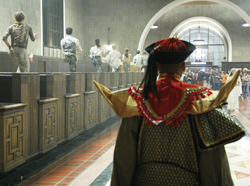
The cast members blend in with the travelers, especially at the beginning of the performance when they first appear, wearing ordinary street clothes. Then, out of nowhere, you hear a musical passage from the orchestra playing in a real room that’s hundreds of feet away. The sound grows in intensity, then diminishes, and then takes flight in various musical modalities. It’s an overture. This is the start of the experience.
Now a solo voice appears in your headphones, and you’re eager to see where it might be coming from. It’s by no means obvious. There’s a lot of space around you. You see a bustle in the crowd of your fellow headphone wearers, so you follow them for a while. Do they know where they’re going? Are they just guessing? Before too long you find the source of the voice. It’s a man in a wheelchair singing a poignant passage in operatic style, backed by the invisible orchestra.
Soon he is joined by another voice, a man dressed in typical transit station clothing, and wearing a shabby backpack. Again, it takes a while to realize where the second voice is coming from and who might be the vocalist. You visually explore the area and it’s very hard to separate the legitimate passengers in this rail terminal from those who might be cast members. The search is on for the tell-tale IEMs and headset mics, but both are well disguised. If you don’t have a close-up view of the performer, you cannot be sure if he/she is in the cast…or just a passenger wandering by.
The first actors have drifted away and new voices appear. Dancers augment the vocalists. Some are pushing brooms, wearing maintenance staff jump-suits. Others are exotic women in beautiful all-white gowns. They begin to appear in and around the large interconnected halls and the outside garden areas of the train terminal. Who do you follow? Where should your attention be directed?
And this is exactly what the producers want you to experience. A highly interactive event, that while scripted and choreographed, becomes a personal experience depending on what catches your attention, and what you decide to do about it. How you determine where you will focus on the different activities that are going on all around you is what makes it unique to each audience member.
Behind It All
The show could not be held without the foundational technology. The folks at Bexel, a company that is accomplished in serving complicated events, closed the loop between top-quality products and the successful deployment of them.
The wireless antenna cables were one of the numerous challenges of the project. They were routed to equipment racks in the control room where the Managed Antenna System components were located. MAS-500 Series equipment, which Bexel manufactures, was used to combine or distribute the various signals as needed. The use of ultra low-loss cables was impractical due to the public space issues, so the tech team had to be creative with amplification and signal routing to deliver the maximum allowable energy to each transmitting antenna and provide the cleanest signal possible for the wireless mic receivers.
“While the science is well known, and one in which Bexel has much experience, we had to apply our knowledge and expertise to an environment that required more than our customary methods,” states Andrew McHaddad, chief engineer for Bexel. “The greatest challenge was working in a public space with such a large, long-term installation. Cables and antennas had to be set up and torn down before and after each night’s performances, risking misconnected cables, incorrectly aimed antennas, and damage to cables due to pedestrian traffic or other forms of stress. The show’s audio department embraced these challenges with great professionalism and skill.”
Senior technical editor Ken DeLoria has mixed innumerable shows and tuned hundreds of sound systems with an emphasis on taming difficult acoustical environments, and he’s also the founder and former owner of Apogee Sound, which developed the TEC Award-winning AE-9 loudspeaker.

